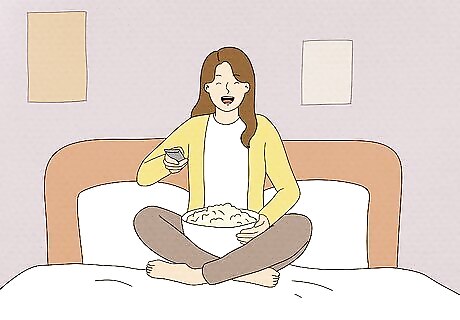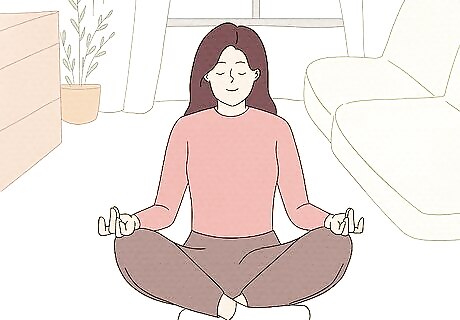
views
X
Research source
Use these effective tips to change your perceptions and cheer yourself up.This article is based on an interview with our licensed clinical psychologist, Rebecca Kason. Check out the full interview here.
Change what you're doing.

If you're upset because you feel stuck in a rut, do something different. Sometimes just getting out of your current activity can alter your mood. If you've been in back-to-back meetings throughout your day with no free time, treat yourself to a funny movie at the end of your day. Changing what you're doing can work wonders on your mood! For example, if you’ve been in a desk chair or on the couch all day, your mood might be low because your body needs some physical activity. Get up, go for a walk, and enjoy the change of pace.
Go outside.
Spending time in nature can reduce stress and lift your mood. Try going for a walk in the park, visiting a garden or arboretum if you live in a city. Being outside can greatly improve your mood. Studies have found that having the opportunity to go outside or visit a garden reduces levels of cortisol, a hormone your body releases when you're stressed. Catch some sunshine. Sunlight exposure can make you more alert and productive, and boost your mood. Just don’t forget sunscreen! However, don’t wait for the perfect day or weather before going outside. Grab an umbrella and take a walk in the rain. Being outdoors can cheer you up, no matter the weather. Try going for a drive if you feel up for it. Roll down the windows and enjoy the breeze! Watch the sunset (or sunrise if you have to be up that early). Taking in that natural beauty might cheer you up.
Exercise.
Exercising releases “feel-good” neurotransmitters to your brain. Get in a workout, play one of your favorite sports or activities, or just be more active in your daily routine. Even just 5 minutes of aerobic exercise has been shown to reduce anxiety. Working in some physical activity can cheer you up by getting those neurotransmitters pumping. For example, if you take your dog for a walk, extend the walk and let yourself enjoy being outside. Or, you can call up some of your friends and get a game of pickup basketball going.
Do something that makes you smile.

Studies have shown that smiling can improve your mood. Even if you don't feel like smiling, remind yourself that just the act of smiling can cheer you up. Find activities that will cause you to smile, such as watching a funny TV show or movie. Or you can talk with a friend who you know always makes you laugh or smile. Pick up a new book from the library and spend an hour or two reading. Buy yourself a small but tasty treat, like an iced coffee or boba. Have a quick dance party at home! Learn something new, even if you just browse Wikipedia pages for a few minutes. Do some finger-painting or fill in a page of a coloring book. Make a self-care document for yourself as you go, so you’ll know what activities to do the next time you feel blue. If you can't take the time to do something enjoyable, just practice smiling when you can. It might feel strange to force it, but it can still cheer you up!
Listen to your favorite tunes.

Uplifting music has the power to change (and boost) your mood. Throw on a record, play a CD, or pull up a Spotify playlist full of happy, upbeat songs and listen to cheer yourself up. Keep in mind that slower, sad songs probably won’t help in this regard (or even faster songs with a sad subject matter). Focus on listening to happy beats only! Try curating a playlist specifically filled with songs you know make you feel happier. That way, you’ll have something to go to when you’re in a bad mood.
Meditate daily.

Meditation can enhance both your mood and emotional well-being. Even just a few minutes of meditation can start making a difference! Try meditating for at least 5 minutes daily (although you can do more if you want). The meditation can calm you down, soothe any anger or worry, and leave you feeling much happier and less moody. In the long term, meditation can even improve your memory and focus. Alternatively, stretch out your body by doing a few simple yoga exercises. Like meditation, yoga can reduce stress and improve your mental health. If you aren’t in the mood for yoga or meditation, at least try some breathing exercises to help yourself get in a more relaxed state of mind.
Hug someone you love.

Physical affection releases feel-good hormones to boost your mood. Namely, hugging can trigger the release of cortisol and oxytocin, which are powerful mood boosters! So, when you need a pick-me-up, ask someone you feel comfortable with if you can have a hug. After that, spend some time with them (if you have time to spare); being around people you love and trust can also do wonders for your mood. If there’s nobody around to give you a hug, try giving yourself a quick massage by rubbing your temples, forehead, hands, and neck. Want to be with a friend but can’t see them in person? That’s okay. Call or text them instead, and ask if you can talk. Try making plans with your friends to do something fun another day if nobody’s free at the moment. That way, you’ll have something to look forward to.
Cuddle your pet.
Set aside time to spend cuddling or petting your dog or cat. Or, spend time with your pet by playing a game if you prefer being active. Research shows that pets and spending time with pets can alleviate poor moods. In fact, spending time with a pet improves mood just as much as spending time with a loved one or significant other. Not only will cuddling your pet cheer you up, but it can also strengthen your bond with your pet. Want to get outside? If you have a dog, consider taking them to a dog park. You can both run around, get some fresh air, and enjoy playing together.
Make your space more comforting.
Surround yourself with things that cheer you up, including mementos. Do you have favorite photos, souvenirs, mementos, plants, and books? Put them on display—and don’t forget to improve your lighting. Some people who suffer from seasonal affective disorder experience symptoms of depression if they don't have enough sunlight. In a dim room, open up a window for some natural light. If you’re using artificial light, try turning on a lamp or candle to cheer yourself up. If you’re at work and in a bad mood, try introducing things from home to make yourself feel more comfortable. That might mean pictures, a certain air fragrance, or even your favorite tea to serve as a soothing reminder of home.
Make your space smell good.

Fragrances can trigger areas in the brain that connect to emotions. So, a favorite fragrance or good-smelling candle can lift your mood, even if your house doesn’t normally smell bad. Try aromatherapy (inhaling or topically applying essential oils) to cheer yourself up. Studies have found that lemon essential oil, in particular, elevates mood, while lavender oil can reduce stress and anxiety. Researchers are uncertain about what makes essential oils and aromatherapy effective. But, they believe that receptors in your nose stimulate parts of your brain that control emotions and memories. If you plan to apply essential oils topically, do a patch test first on a small area of skin to ensure you won’t have an allergic reaction. Keep in mind that some essential oils (like lavender) aren’t safe to ingest. Always check to see if there’s a recommended way to use your oil of choice.
Clean up your space.
Spend some time cleaning or re-organizing your home or office. Research has shown that having clutter in your apartment or at work can increase your stress level greatly, which can bring down your mood. Try to declutter the space, thus reducing your stress levels and improving your mood. Donate, throw out, or recycle things you no longer need or want. You might even find that organizing things to make them more functional may cheer you up!
Decorate with color.
Color can greatly impact your mood. Consider painting a few rooms or adding decorative elements with a cheerful color to lift your spirits. Yellow is a good choice for brightening a space, while shades of pink might make you feel more playful. Don't think that you have to use the brightest, boldest shade of the color. Even a pale yellow can help you cheer up. Try balancing several shades of cheerful colors. For example, you could alternate yellow and orange stripes to make a room feel more energetic and welcoming.
Distract yourself from your current situation.
Ruminating on your situation too much can make problem-solving harder. It also has a link to depression. So, avoid dwelling on whatever is bringing you down too much. If you find yourself stuck in a pattern of thinking, distract yourself with other activities or thinking about things in your immediate surroundings. For example, you could look around and notice the lighting or the design of the buildings on your way to work. Use brain teasers like puzzles, Sudoku, and crosswords to keep your mind busy and occupied with other things. Try to refocus your thoughts on what you can change or influence. This can remind you that you're in control of your situation and your own happiness.
Recite positive affirmations.

Positive affirmations can inspire and instill confidence in you. They’re also proven to help improve your mood! Positive affirmations are basically designed to help reverse subconscious (or overt) negative thoughts that can bring you down. So, when you’re having a bad day and recognize that negative thoughts might be part of the problem, recite positive affirmations to get into a happier mindset. For example: I’m overflowing with energy, enthusiasm, and joy. I am using my amazing talents to fulfill all of my dreams. I always find solutions to the challenges in front of me, and move past them. I am calm and centered today. I can do anything I set my mind to. I have all the tools I need to do what needs to be done today. I am smart and capable, and I can stand up for myself.
Reframe your situation or mood.

Think about life from a different perspective. Reframing is a term counselors use to get you to look at your situation in a new light or from a different angle. You might try looking for the silver lining in your situation, remembering what you've learned, or finding humor in a less than optimal situation. Or, if you’re just in an odd mood and feel grumpy, you can remind yourself that not every day is a cheery day and that tomorrow will be better. For example, if you’re sad after a breakup, you might remind yourself that although the end of the relationship has been painful, you learned a lot about yourself through the process.
Practice gratitude.
Being thankful for the world around you can lift your spirits. Gratitude is an attitude, a moral outlook, or even a daily practice that shows thankfulness. It can also mean showing appreciation and repaying kindness. Try setting a daily reminder on your phone. When prompted, take a moment to be thankful for one thing that day. Or, just try to notice things throughout the day that you’re grateful for. The things you’re grateful for can be small things, like finding a close parking spot or seeing a beautiful sunrise. At the end of the day, make a quick gratitude list and write down 3 things that you were thankful for that day. Being grateful can put you in a mood of thankfulness and optimism. Studies have shown that it can also improve your well-being and interpersonal relationships. Studies have also shown that gratitude can make you feel more optimistic about the future and improve your outlook.




















Comments
0 comment